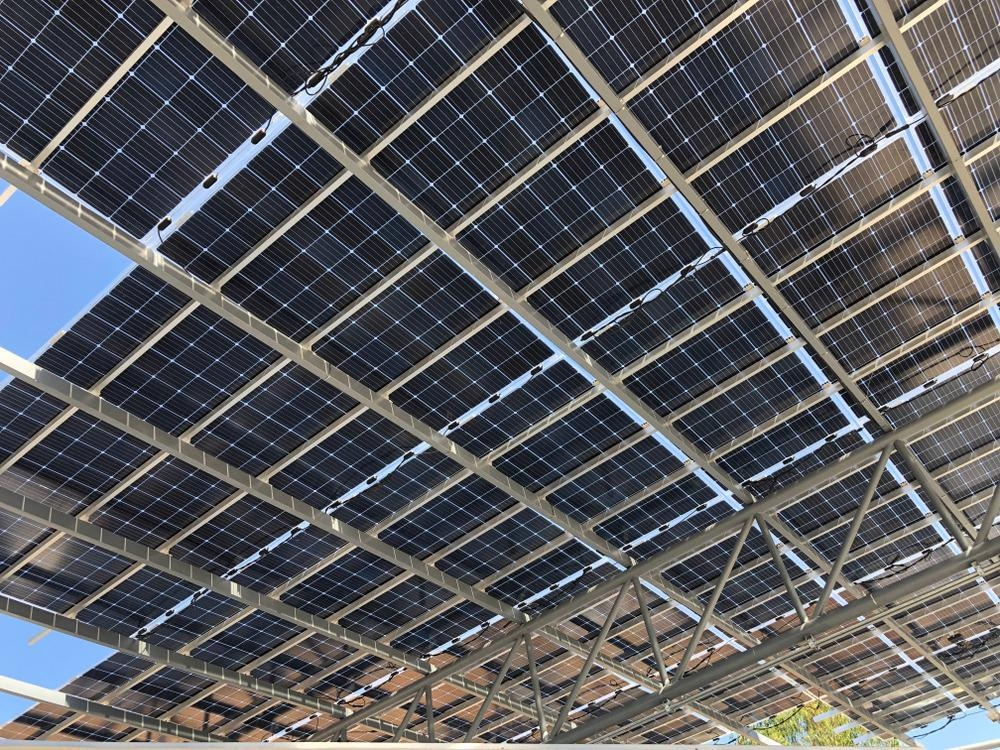Optimizing Quantum Dots to Maximize Solar Panel Efficiency


Researchers in Australia have developed an algorithm that accurately calculates the size and density of quantum dots needed to boost solar panels to maximum efficiency.
Researchers at Monash University in Australia, which is a member of the Australian Research Council's ARC Centre of Excellence in Exciton Science, believe that if their findings are fully realized, the operating efficiency of solar cells will greatly exceed the current record and reach a level well ahead of the curve.
?
Photofusion with PbS Quantum Dots
Quantum dot technology has long been in the spotlight for its promise to break the efficiency limit of solar cells, which is typically the Shockley-Queisser efficiency limit (~33%).
Quantum dots can be used in photofusion (or photochemical upconversion) to convert "wasted" light into electrical current for solar cells. The photofusion process uses light "sensitizers" and light "emitters" to convert photons with energies below the solar cell's bandgap into higher-energy photons that would otherwise not be converted into electrical current. This increases the amount of light that can be effectively utilized by the cell, thereby improving efficiency.
Existing research on the application of quantum dot technology to photovoltaics has shown that quantum dot sensitizers outperform organic sensitizers traditionally used in photofusion. This is due to the high photostability and absorption properties of quantum dots: specifically, their absorption coefficients are very large and the absorption cross section can be "tuned" over a wide energy range.
When choosing a sensitizer, the Monash University researchers decided to use quantum dots of the IV-VI group of elements because they have the required energy levels, are suitable for large-scale synthesis, and can be tuned to absorb light below the bandgap of silicon, the most commonly used material for solar cells.
Within the IV-VI family of quantum dots, lead sulfide (PbS) was chosen for the study because it is elementally abundant and has been commonly synthesized.
?
Optimized Quantum Dots
After a series of experimental validations, researchers at Monash University have found that a PbS quantum dot sensitizer with a quantum radius of about 2.2 nanometers produces the best results in silicon solar cells, with metric performance that far exceeds current records. This result, obtained in a silicon environment, is an important finding. Existing experiments have used organic sensitizers that are not compatible with silicon solar cells, and given that silicon is the predominant photovoltaic technology used in solar cells today, this is actually a considerable breakthrough for commercial applications.
The large range of radii and concentrations suggests that optimization on an order-of-magnitude level is possible, if achieved, even under the requirement of needing compatibility with silicon. The findings also provide insight into the relationship between the size of the quantum dots and the range of the solar spectrum captured by the solar cell and its impact on energy efficiency.
A preliminary interpretation of the laws of physics that apply to quantum dots suggests that larger quantum dots can capture more of the sun's spectrum, and do so more efficiently. Although the Monash researchers say the model is "conceptually sound," they found that it must be refined in four key details:
- Because of the complex structure of the near-infrared spectrum of sunlight at Earth's surface due to the presence of water in the Earth's atmosphere, the color of the quantum dots had to be adjusted to the peaks of the sunlight;
- Ultra-large quantum dots have low colloidal stability and, because they cannot overlap, their concentration has to be sacrificed to increase their size;
- Quantum dots are opaque at energies above the first excited state;
- Energy must be transferred exothermically from the sensitizer to the emitting molecule.
?
Commercial Prospects and Future Development
In principle, PbS quantum dots are compatible with all photovoltaic elements with a bandgap larger than bulk PbS. Since the photofusion process can be synthesized in liquid form, it is also likely to be cheap enough that even a small price advantage may be economically viable.
To be commercially viable, PbS photoreceptors require corresponding photoemitters that provide efficient energy transfer from the photoreceptor to the emitter, stable energy storage, efficient fluorescence, and a number of other properties. According to the researchers, all of these properties have been verified experimentally separately, but not yet simultaneously.
Dr. László Fraser, co-author of the paper, emphasized that in order to maximize the efficiency of solar cells, we must deepen our understanding of every element in the solar chain, from the sun and the atmosphere to the solar cell and the quantum dots themselves. The study's co-author, Benedicta Sherry, hopes that the research "will ultimately lead to greater societal reliance on photovoltaic solar energy, which is not only efficient, but also affordable." The researchers' algorithm is free to use and can simulate scenarios with different light, absorption and emission spectra.
?
References
1. Benedicta Sherrie, Alison M. Funston, Laszlo Frazer (2020) Optimal quantum dot size for photovoltaics with fusion.?Nanoscale.?https://doi.org/10.1039/D0NR07061K
2. Octavi E. Semonin, Joseph M. Luther, Matthew C. Beard (2012) Quantum dots for next-generation photovoltaics.?Materials Today.?https://doi.org/10.1016/S1369-7021(12)70220-1
 首页
首页 400-620-6333
400-620-6333



 危险品化学品经营许可证(带存储)
危险品化学品经营许可证(带存储)